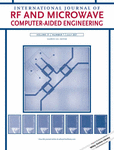A circularly polarized microstrip patch antenna with enhanced bandwidth based on substrate integrated waveguide techniques
Funding information: National Natural Science Foundation of China
Abstract
In this article, a circularly polarized (CP) microstrip patch antenna (MPA) is proposed. The antenna adopts a substrate integrated waveguide (SIW) cavity and a microstrip patch as the feed structure and the radiator, respectively. In consequence, the patch dominates the radiation and improves the radiation efficiency, while the asymmetric SIW cavity enhances the bandwidth and generates a pair of degenerate modes, which provide the quadrature phase shift that the CP radiation requires. By this mean, the proposed antenna not only brings up a novel feed structure for CP MPA and improves its effective bandwidth, but also circumvent the limitation of the SIW cavity slot antenna, which is low radiation efficiency. Plus, the presented antenna remains the advantages of SIW structure, including high Q factor, high integrate compatibility, and so forth. The antenna was fabricated and measured, and the presented antenna exhibits an impedance bandwidth of 12% (from 2.09 to 2.36 GHz), an axial ratio bandwidth of 7.73% (from 2.15 to 2.32 GHz) with a minimum gain of 7.89 dB. The experiment results indicate a good agreement with the simulation.
Open Research
DATA AVAILABILITY STATEMENT
I confirm that my Data Availability Statement complies with the Expects Data Policy.




